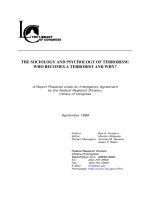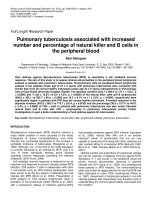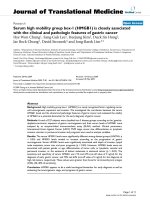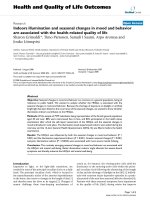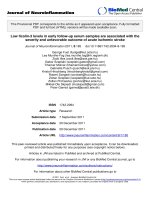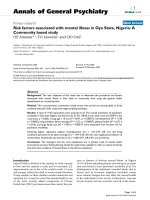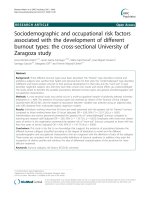Risk factors associated with the progression and metastases of hindgut neuroendocrine tumors: A retrospective study
Bạn đang xem bản rút gọn của tài liệu. Xem và tải ngay bản đầy đủ của tài liệu tại đây (900.17 KB, 7 trang )
Okubo et al. BMC Cancer (2017) 17:769
DOI 10.1186/s12885-017-3769-4
RESEARCH ARTICLE
Open Access
Risk factors associated with the progression
and metastases of hindgut neuroendocrine
tumors: a retrospective study
Yoichiro Okubo1* , Rika Kasajima2, Masaki Suzuki1, Yohei Miyagi2, Osamu Motohashi3, Manabu Shiozawa4,
Emi Yoshioka1, Kota Washimi1, Kae Kawachi1, Yoichi Kameda1 and Tomoyuki Yokose1
Abstract
Background: The worldwide incidence of neuroendocrine tumors (NETs) has increased remarkably, with the
hindgut being the second most common site for such tumors. However, the mechanisms underlying progression
and metastasis of hindgut NETs are unclear. A retrospective study was conducted to elucidate these mechanisms.
Methods: Clinicopathological data of cases of hindgut NET between April 1996 and September 2015 were analyzed,
retrospectively. Patients with neuroendocrine carcinoma were excluded. Formalin-fixed paraffin-embedded tissues of
hindgut NET cases were subjected to detailed morphometric and immunohistochemical analyses. Statistical analyses
were performed using the non-parametric Mann-Whitney U test, Spearman’s correlation coefficient, and chi-squared
test. Multivariate logistic regression analysis was conducted as appropriate for the data set.
Results: Fifty-six hindgut NET cases were considered. Microvessel density and lymphatic microvessel density were
identified as significant risk factors for venous and lymphatic invasion. There was a positive correlation between
microvessel density and the maximum tumor diameter. Multivariate logistic regression analysis revealed that the
maximum tumor diameter alone was an independent predictor of lymph node metastasis, whereas lymphovascular
invasion and MVD was not the predictor of lymph node metastasis. There were no significant correlations between the
Ki-67 labeling index and any of the parameters evaluated including age, sex, the maximum tumor diameter, venous
invasion, lymphatic invasion, microvessel density, lymphatic microvessel density, and lymph node metastasis.
Conclusions: Angiogenic mechanisms may play important roles in the progression of hindgut NET. Otherwise, the
maximum tumor diameter alone was an independent predictor of lymph node metastasis in hindgut NETs. Moreover,
our study raises the question of whether the presence of lymphovascular invasion, in endoscopically obtained hindgut
NET tissues, is an absolute indication for additional surgery or not.
Keywords: Neuroendocrine tumor, Hindgut, Angiogenesis, Microvessel density, Lymphatic microvessel density,
Lymphovascular invasion
Background
Neuroendocrine tumors (NETs) arise in many organs and
the majority of them are gastroenteropancreatic neuroendocrine tumors (GEP-NETs) [1–3]. While the occurrence
of GEP-NETs has been regarded relatively rare [4], a study
recently reported a steady increase in the incidence and
prevalence of GEP-NETs [1]. Globally, the midgut is the
* Correspondence:
1
Department of Pathology, Kanagawa Cancer Center, 2-3-2, Nakao, Asahi-Ku,
Yokohama, Kanagawa 241-8515, Japan
Full list of author information is available at the end of the article
most common site of GEP-NETs; however, the fact that
the hindgut is the second most common site could
account for the remarkable increase in incidence [5, 6].
The World Health Organization (WHO) grading system
for GEP-NETs was updated in 2010 [4]. This grading system is based on the proliferative activities of tumor cells
(mitotic counts and Ki-67 labeling index). Indeed, both high
levels of mitotic activity and Ki-67 immunoreactivity are associated with poor prognosis in perspective. Nevertheless,
hindgut NET cases with relatively low levels of proliferative
activities may have discordant tumor progression, invasion,
© The Author(s). 2017 Open Access This article is distributed under the terms of the Creative Commons Attribution 4.0
International License ( which permits unrestricted use, distribution, and
reproduction in any medium, provided you give appropriate credit to the original author(s) and the source, provide a link to
the Creative Commons license, and indicate if changes were made. The Creative Commons Public Domain Dedication waiver
( applies to the data made available in this article, unless otherwise stated.
Okubo et al. BMC Cancer (2017) 17:769
metastasis, and/or overall prognosis [4, 7, 8]. To elucidate
hidden risk factors for hindgut NETs, we previously conducted a pathological study using endoscopically resected
specimens of hindgut NET and proposed that angiogenesis
plays an important role in the initial phase (occurrence and
progression) of this tumor [4]. To obtain a more detailed
and accurate assessment of the mechanisms of hindgut NET
progression and metastasis, we sampled a greater number of
patients, including those who had undergone surgery.
Methods
Study design
In this retrospective study, data from patients with NET
G1-G2 treated at our Institute between April 1996 and
December 2015 was analyzed. We adopted a similar procedure as used previously, to identify cases of hindgut
NETs [4]. Using the database system for the anatomic
pathology ("EXpath" Laboratory Information Systems for
Pathology, INTEC Inc, Tokyo, Japan.), we searched
pathological records between April 1996 and December
2015, and subsequently retrieved the formalin-fixed
paraffin-embedded (FFPE) tissue sections of the identified hindgut NET cases (including, tissue sections obtained from both endoscopic and surgical procedures).
Data from patients with neuroendocrine carcinoma (NEC)
were excluded because: (i) the clinical management of NEC
is different [9], and (ii) studies have shown that colorectal
NEC and hindgut adenocarcinoma have a similar mutation
profile that differs from that of NET G1-G2 [10, 11].
Clinicopathological data of identified hindgut NET cases
As previously reported [4], the clinicopathological data
were analyzed for age, sex, tumor site, the maximum tumor
diameter, depth of tumor invasion, lymphovascular invasion, the status of lymph node, and distant metastasis. The
maximum tumor diameter was defined as largest tumor
size based on macroscopic and pathological examination.
Page 2 of 7
Immunohistochemical examinations were also performed
using antibodies against the following markers: CD31
(Leica, clone 1A10; 1:20 dilution), chromogranin A (Roche,
clone LK2H10; 1:5 dilution), D2–40 (Roche, clone D2–40;
1:1 dilution), Ki-67 (Dako, clone MIB-1; 1:50 dilution), and
synaptophysin (Roche, clone MRQ-40; 1:1 dilution). Tumor
cells, which showed positive reactivity for synaptophysin
and/or chromogranin A were analyzed in the present study
(≥50% reactivity was defined as positive).
The Ki-67 labeling index was calculated using the
Patholoscope image analysis software (MITANI Corporation, Japan, URL: />Besides, we calculated the microvessel density (MVD)
and lymphatic microvessel density (LMVD) values of the
specimens of the intratumoral area. MVD was defined as
the number of blood vessels per unit area of tumor tissue (immunohistopathological images of the CD31 were
used), while LMVD was defined as the number of
lymphatic vessels per unit area (immunohistopathological images of the D2–40 were used).
Statistical analyses
Appropriate statistical analyses were performed on the
extracted data. Statistical analyses were performed using
the non-parametric Mann-Whitney U test, Spearman
correlation coefficient, chi-square test, and a multivariate
logistic regression analysis as appropriate for the data
set. Differences were considered significant at P < 0.05.
All statistical analyses were performed using IBM SPSS
Statistics version 22 (IBM Corp., Armonk, NY, USA).
Results
Fifty-six cases with available FFPE specimens were analyzed (Fig. 1). Clinicopathological data are summarized in
Table 1. Fourty four patients underwent an endoscopic
Fig. 1 Representative images of histopathological findings in hindgut neuroendocrine tumors. a A photomicrograph showing a low-power field
image of a hindgut neuroendocrine tumor (NET). The tumor cells are arranged in a trabecular pattern and show solid nests (Hematoxylin and eosin
(HE) staining; original magnification, ×40; scale bar represents 1000 μm). b A photomicrograph showing a high-power field image of a hindgut NET.
The tumor cells are uniform, arranged in rounded, solid nests, and have round-to-oval nuclei. Mild nuclear atypia can be seen (HE staining; original
magnification, ×400; scale bar represents 100 μm)
Okubo et al. BMC Cancer (2017) 17:769
Page 3 of 7
Table 1 Clinicopathological characteristics of participants with
hindgut NET
Characteristics
Age (years)
Mean ± SD
59.5 ± 12.7
Range
27–84
Sex (n, %)
Male
35 (62.5%)
Female
21 (37.5%)
The maximum tumor diameter (mm)
Mean ± SD
7.7 ± 7.9
Range
2.2–50.0
Ki 67 labeling index (%)
Mean ± SD
1.3 ± 1.1
Range
0.0–4.2
Venous invasion (n, %)
Negative
39 (69.6%)
Positive
17 (30.4%)
Lymphatic invasion (n, %)
Negative
39 (69.6%)
Positive
17 (30.4%)
presented with lymph node and liver metastasis died
36 months after surgery. The remaining 12 patients died
from other diseases causes (four cases involving gastric
cancer, individual cases involving cerebral hemorrhage, extrahepatic cholangiocarcinoma, malignant lymphoma, rectal adenocarcinoma, and small cell lung cancer and causes
of death were unknown for three cases).
Pathological investigations revealed that 55 of 56 hindgut NETs were located in the rectum; the remaining
NETs developed in the sigmoid colon. The mean maximum tumor diameter was 7.7 ± 7.9 mm (range, 2.2–
50 mm). In 54 of 56 cases, the tumor invaded into the
submucosal layer, and into the muscularis propria in the
remaining two cases. Level 1 lymph node metastasis was
observed in eight patients. Positive immunoreactivity for
synaptophysin and/or chromogranin A was confirmed in
all 56 cases (Fig. 2). The mean Ki-67 labeling index was
1.3 ± 1.1% (range, 0–4.2%, Fig. 2). Based on the Ki-67 labeling index, 41 and 15 cases were classified as NETs G1
and G2, respectively. Both venous and lymphatic invasion was identified in 17 cases each (30.4%). Mean MVD
was 32 ± 31.2/mm2 (range, 1.4–136.9/mm2), and mean
LMVD was 9.4 ± 10.9/mm2 (range, 0.35–55/mm2).
Risk factors for metastasis
MVD (mm2)
Mean ± SD
32.0 ± 31.2
Range
1.4–136.9
LMVD (mm2)
Mean ± SD
9.4 ± 10.9
Range
0.35–55.0
NET neuroendocrine tumor, MVD Microvessel density, LMVD Lymphatic
microvessel density, SD Standard deviation
procedure for removal; the remaining 12 patients underwent a surgical procure. The mean age (± standard deviation: SD) was 59.5 ± 12.7 years (range, 27–84 years), with
a male-to-female ratio of 5:3 (35:21). The follow-up period
ranged from 11 months to 290 months. While relatively a
large number of patients remain alive, 13 of 56 patients
died from various diseases. Especially, one patient who
In the present study, because distant metastasis was
found in one patient alone, who eventually died because of the NET, it was not possible to determine the
prognostic impact of distant metastasis as a risk factor. Therefore, lymph node metastasis was evaluated
as indirect evidence for risk factors associated with
metastasis. In the univariate analyses, the maximum
tumor diameter (Mann-Whitney U test, P < 0.001,
Fig. 3), venous invasion (Mann-Whitney U test, P =
0.033), and MVD (Mann-Whitney U test, P < 0.001)
were significant risk factors for lymph node metastasis
in hindgut NETs. Multivariate logistic regression analysis (Table 2) revealed that the maximum tumor
diameter was an independent predictor of lymph node
metastasis (odds ratio, 1.5; 95% confidence interval
(CI), 1.04–2.15; P = 0.03). By contrast, venous invasion
Fig. 2 Immunohistochemical reactivity for synaptophysin, chromogranin A, and Ki-67 in hindgut neuroendocrine tumors. Representative photomicrographs of
immunohistochemical staining. a Tumor cells showed strong positive reactivity for synaptophysin (original magnification, ×100; scale bar represents 300 μm).
b Tumor cells showed sporadic positive reactivity for chromogranin A (original magnification, ×100; scale bar represents 300 μm). c A few tumor cells showed
positive reactivity for Ki-67 (original magnification, ×100; scale bar represents 300 μm)
Okubo et al. BMC Cancer (2017) 17:769
Page 4 of 7
Fig. 3 Differences in the maximum tumor between tumors with and
without lymph node metastasis. The maximum tumor diameter in
patients with lymph node metastasis was significantly larger compared
with that in those without lymph node invasion. The maximum tumor
diameter was a significant risk factor for lymph node invasion in hindgut
neuroendocrine tumors
(odds ratio, 0.27; 95% CI, 0.02–4.40; P = 0.36) and
MVD (odds ratio, 1.04; 95% CI, 1.00–1.08; P = 0.08)
were not independent risk factors for lymph node
metastasis.
Practical implications of MVD and LMVD
MVD values were higher in tumors with venous invasion
(mean, 58 ± 38.9/mm2) compared to those without venous invasion (mean, 20.7 ± 17.9/mm2; Mann-Whitney U
test, P < 0.001; Fig. 4). LMVD values were higher in
tumors with lymphatic invasion (19.3 ± 14.7/mm2) compared to those without lymphatic invasion (mean 5.0 ±
4.1/mm2; Mann-Whitney U test, P < 0.001; Fig. 5).
Therefore, in hindgut NETs, MVD and LMVD could be
considered as significant risk factors for venous and
lymphatic invasion, respectively. Moreover, there was a
positive correlation between the maximum tumor
diameter and MVD (r = 0.735; Spearman’s correlation
coefficient, P < 0.001; Fig. 6).
Fig. 4 Differences in microvessel density between tumors with and
without venous invasion. The microvessel density (MVD) in tumors
with venous invasion was significantly higher compared with that in
tumors without venous invasion. MVD was a significant risk factor for
venous invasion in hindgut neuroendocrine tumors (Mann–Whitney U
test, P < 0.001; values are expressed as the mean ± standard deviation)
Discussion
Recently, an increased incidence of GEP-NETs has been
reported globally, with the rectum, considered as the
“intestine” of the hindgut, being the most common site
of occurrence [1, 12]. Therefore, elucidating the mechanisms of hindgut NET progression and metastasis is
important, and this study was specifically conducted to
evaluate the risk factors associated with tumor progression and metastasis in hindgut NET.
In the univariate analyses, the maximum tumor diameter, venous invasion, and MVD were determined as
significant risk factors for lymph node metastasis in hindgut NET. The maximum tumor diameter and the presence of lymphovascular invasion are generally known as
important predictive factors for any tumor [3, 13–21].
However, results of our multivariate logistic regression
analysis of lymph node metastasis revealed that the maximum tumor diameter alone was an independent predictor of lymph node metastasis, whereas lymphovascular
Practical implications of the Ki-67 labeling index
In the present study, there were no significant correlations between the Ki-67 labeling index and any of the
parameters evaluated (i.e., age, sex, the maximum tumor
diameter, venous invasion, lymphatic invasion, MVD,
LMVD, and lymph node metastasis).
Table 2 Multivariate logistic regression analysis of lymph node
metastasis
Variables
Tumor size
Odds ratio
1.50
P-values
95% CI
Lower
boundary
Upper
boundary
1.04
2.15
0.03
Venous Invasion
0.27
0.02
4.40
0.36
MVD
1.04
1.00
1.08
0.08
CI confidence interval, MVD micro vessel density
Fig. 5 Differences in lymphatic microvessel density between tumors
with and without lymphatic invasion. The lymphatic microvessel
density in tumors with lymphatic invasion was significantly higher
compared with that in tumors without lymphatic invasion. LMVD
was a significant risk factor for lymphatic invasion in hindgut
neuroendocrine tumors (Mann–Whitney U test, P < 0.001; values are
expressed as the mean ± standard deviation)
Okubo et al. BMC Cancer (2017) 17:769
Page 5 of 7
Fig. 6 Scatter plots of the hindgut neuroendocrine tumor between the maximum tumor diameter and microvessel density. A significant positive
correlation was found between microvessel density and the maximum tumor diameter (r = 0.735, P < 0.001, Spearman correlation coefficient)
invasion and MVD was not the predictor of lymph node
metastasis. This finding indicated that the most important
factor in the clinical management of patients with hindgut
NET is the maximum tumor diameter. Actually, approximately 30% of patients had the lymphovascular invasion,
but there were no significant correlations between
lymphovascular invasion and lymph node metastasis. In
general, additional surgery is recommended if the lymphovascular invasion was detected in endoscopically resected
specimens of hindgut NET [22–24]. However, our data indicated that the lymphovascular invasion in endoscopically resected specimens of hindgut NET might not be the
absolute indication for additional surgery. In fact, other investigators also advocated that further studies need to determine whether additional surgery is necessary or not for
patients who are detected lymphovascular invasion in
endoscopically resected specimens [25–27]. Although our
study has not yet denied the pathological significance of
lymphovascular invasion, it raises the question of whether
the presence of lymphovascular invasion, in endoscopically obtained hindgut NET tissues, is an absolute indication for additional surgery or not.
Meanwhile, what is intriguing for us is that no significant correlations were identified between the Ki-67
labeling index and any parameter (age, sex, the
maximum tumor diameter, venous invasion, lymphatic
invasion, MVD, LMVD, and lymph node metastasis). In
general, Ki-67 labeling index is regarded as a prognostic
factor for many neoplasms [7, 28–33]. However, we wish
to emphasize that Ki-67 labeling index is not an absolute
prognostic factor in hindgut NET cases with the relatively low level of proliferative activities.
Regarding the morphometric analyses of MVD and
LMVD, further discussion is warranted because previous
studies have reported that NETs usually have a high
MVD [34]. A high MVD would imply that NETs possess
substantial angiogenic activity. Besides, because there
was a positive correlation between MVD and the maximum tumor diameter in the present study, one could
conclude that an angiogenic mechanism plays a major
role in the progression of hindgut NET. Furthermore,
since MVD was a significant risk factor for venous invasion, tumor progression and high MVD might be associated with hematogenous metastasis. Therefore,
molecular, biological, and genetic analyses [35–38] of
factors such as the angiogenesis-related genes could provide the key to elucidating the mechanisms of hindgut
NET progression and/or metastasis.
By contrast, although LMVD was a significant risk factor of lymphatic invasion, no significant correlation was
identified between LMVD and lymph node metastasis in
the present study. Similarly, a previous study in patients
with breast cancer failed to find any significant correlation between LMVD and lymph node metastasis [39].
Under certain circumstances, tumor progression might
destroy the lymphatic vessels resulting in a subsequent
decrease in LMVD. Thus, the pathologist should be
aware of false-negative results in the assessment of
lymphatic invasion in hindgut NET, despite there are
many questions regarding the pathological significance
of lymphovascular invasion. However, the limitations of
our study need to be considered in the interpretation of
our results. Foremost, this is a retrospective case series
and relatively small sample size, therefore, are subject to
the inherent biases.
Conclusion
Since a positive correlation was identified between MVD
and the maximum tumor diameter, angiogenic pathways
may play a major role in the progression of hindgut NET.
Therefore, molecular, biological, and genetic analyses of
factors such as the angiogenesis-related factors could provide the key to elucidate the mechanisms of hindgut NET
progression and/or metastasis.
Okubo et al. BMC Cancer (2017) 17:769
Otherwise, a multivariate logistic regression analysis of
lymph node metastasis revealed that the maximum
tumor diameter alone was an independent predictor of
lymph node metastasis in hindgut NET.
Moreover, although our study has not yet denied
the pathological significance of lymphovascular invasion, it raises the question of whether the presence of
lymphovascular invasion, in endoscopically obtained
hindgut NET tissues, is an absolute indication for
additional surgery or not.
Abbreviations
FFPE: Formalin-fixed paraffin-embedded; GEP-NETs: Gastroenteropancreatic
neuroendocrine tumors; LMVD: Lymphatic microvessel density;
MVD: Microvessel density; NETs: Neuroendocrine tumors; SD: Standard
deviation; WHO: World Health Organization
Acknowledgements
Authors extend their appreciation to Sachie Osanai and Mitsuyo Yoshihara
for their excellent technical support. Authors would also like to thank Editage
(www.editage.jp) for language editing.
Funding
This work was supported by JSPS KAKENHI (Grant Number: JP17K08713) from
the Ministry of Education, Culture, Sports, Science, and Technology of Japan.
The funding did not play role in the design of the study and collection,
analysis, and interpretation of data and in writing the manuscript.
Availability of data and materials
The dataset supporting the conclusions of this article are included within the
article (Figs. 1, 2, 3, 4, 5, 6 and Tables 1, 2). In addition, all measurements
were collected and recorded in Microsoft Excel, and the slides stored in the
Surgical Pathology archives at the Kanagawa Cancer Center. All materials will
be made available upon request from the corresponding author.
Authors’ contributions
YO conceptualized this study, integrated the data, performed the statistical
evaluation, and wrote the manuscript. RK, MS, and YM performed a part of the
morphometric analyses of MVD/LMVD and the statistical analyses. OM
performed the endoscopic procedures and extracted clinical data from the
electronic medical record system of our institute. MS performed the surgery
and advised the first author as the chief doctor of gastroenterological surgery.
EY, KW, KK, and YK integrated the clinicopathological data of patients with the
tumor characteristics and a part of the histopathological examinations. TY
performed a part of the histopathological examinations, integrated the data
and revised the manuscript. All authors read and approved the final manuscript.
Ethics approval and consent participate
This retrospective study was performed in accordance with the Declaration
of Helsinki and approved by the Ethics Review Committee of Kanagawa
Cancer Center, Kanagawa, Japan (Approval Number: 27–38). Furthermore,
written informed consent was obtained at the time of clinical intervention
for the future use of material for research in all cases.
Consent for publication
Not applicable.
Competing interests
The authors declare that they have no competing interests.
Publisher’s Note
Springer Nature remains neutral with regard to jurisdictional claims in
published maps and institutional affiliations.
Author details
1
Department of Pathology, Kanagawa Cancer Center, 2-3-2, Nakao, Asahi-Ku,
Yokohama, Kanagawa 241-8515, Japan. 2Molecular Pathology and Genetics
Division, Kanagawa Cancer Center Research Institute, 2-3-2, Nakao, Asahi-Ku,
Page 6 of 7
Yokohama, Kanagawa 241-8515, Japan. 3Department of Gastroenterology,
Kanagawa Cancer Center, 2-3-2, Nakao, Asahi-Ku, Yokohama, Kanagawa
241-8515, Japan. 4Department of Gastrointestinal Surgery, Kanagawa Cancer
Center, 2-3-2, Nakao, Asahi-Ku, Yokohama, Kanagawa 241-8515, Japan.
Received: 6 July 2017 Accepted: 9 November 2017
References
1. Fraenkel M, Kim M, Faggiano A, de Herder WW, Valk GD, Knowledge N.
Incidence of gastroenteropancreatic neuroendocrine tumours: a systematic
review of the literature. Endocr Relat Cancer. 2014;21:R153–63.
2. Hackeng WM, Hruban RH, Offerhaus GJ, Brosens LA. Surgical and molecular
pathology of pancreatic neoplasms. Diagn Pathol. 2016;11:47.
3. Sevilla I, Segura A, Capdevila J, Lopez C, Garcia-Carbonero R, Grande E, et al.
Management of controversial gastroenteropancreatic neuroendocrine
tumour clinical situations with somatostatin analogues: results of a Delphi
questionnaire panel from the NETPraxis program. BMC Cancer. 2016;16:858.
4. Okubo Y, Motohashi O, Nakayama N, Nishimura K, Kasajima R, Miyagi Y, et
al. The clinicopathological significance of angiogenesis in hindgut
neuroendocrine tumors obtained via an endoscopic procedure. Diagn
Pathol. 2016;11:128.
5. Kim ST, Ha SY, Lee J, Hong SN, Chang DK, Kim YH, et al. The
Clinicopathologic features and treatment of 607 hindgut neuroendocrine
tumor (NET) patients at a single institution. Medicine (Baltimore).
2016;95:e3534.
6. Maggard MA, O'Connell JB, Ko CY. Updated population-based review of
carcinoid tumors. Ann Surg. 2004;240:117–22.
7. Okubo Y, Yokose T, Motohashi O, Miyagi Y, Yoshioka E, Suzuki M, et al.
Duodenal rare neuroendocrine tumor: Clinicopathological characteristics of
patients with Gangliocytic Paraganglioma. Gastroenterol Res Pract.
2016;2016:5257312.
8. Okubo Y, Wakayama M, Nemoto T, Kitahara K, Nakayama H, Shibuya K, et al.
Literature survey on epidemiology and pathology of gangliocytic
paraganglioma. BMC Cancer. 2011;11:187.
9. Ebata T, Shimoi T, Ishiwata T, Iwasawa S, Bun S, Yunokawa M, et al.
Amrubicin Monotherapy for patients with platinum-pretreated nongastrointestinal non-pancreatic Extrapulmonary neuroendocrine carcinoma.
Oncology. 2017;
10. Jesinghaus M, Konukiewitz B, Keller G, Kloor M, Steiger K, Reiche M, et al.
Colorectal mixed adenoneuroendocrine carcinomas and neuroendocrine
carcinomas are genetically closely related to colorectal adenocarcinomas.
Mod Pathol. 2017;30:610–9.
11. Sorbye H, Strosberg J, Baudin E, Klimstra DS, Yao JC. Gastroenteropancreatic
high-grade neuroendocrine carcinoma. Cancer. 2014;120:2814–23.
12. Spychalski M, Koptas W, Zelga P, Dziki A. Role of endoscopic submucosal
dissection in treatment of rectal gastroenteropancreatic neuroendocrine
neoplasms. Prz Gastroenterol. 2017;12:17–21.
13. Modlin IM, Lye KD, Kidd M. A 5-decade analysis of 13,715 carcinoid tumors.
Cancer. 2003;97:934–59.
14. Yamagishi D, Matsubara N, Noda M, Yamano T, Tsukamoto K, Kuno T, et al.
Clinicopathological characteristics of rectal carcinoid patients undergoing
surgical resection. Oncol Lett. 2012;4:910–4.
15. Dellaportas D, Koureas A, Contis J, Lykoudis PM, Vraka I, Psychogios D, et al.
Contrast-enhanced color Doppler ultrasonography for preoperative
evaluation of sentinel lymph node in breast cancer patients. Breast Care
(Basel). 2015;10:331–5.
16. Haga T, Fukuoka M, Morita M, Cho K, Tatsumi KA. Prospective analysis of the
efficacy and complications associated with deep sedation with midazolam
during Fiberoptic bronchoscopy. J Bronchology Interv Pulmonol. 2016;23:106–11.
17. Akimoto J, Fukuhara H, Suda T, Nagai K, Ichikawa M, Fukami S, et al.
Clinicopathological analysis in patients with neuroendocrine tumors that
metastasized to the brain. BMC Cancer. 2016;16:36.
18. Legakis I, Saif MW, Syrigos K. Therapeutic challenges in neuroendocrine
tumors. Anti Cancer Agents Med Chem. 2017;
19. Legakis I, Mantzouridis T, Bouboulis G, Chrousos GP. Reciprocal changes of
serum adispin and visfatin levels in patients with type 2 diabetes after an
overnight fast. Arch Endocrinol Metab. 2016;60:76–8.
20. Guo X, Zheng L, Jiang J, Zhao Y, Wang X, Shen M, et al. Blocking NF-kappaB
is essential for the immunotherapeutic effect of recombinant IL18 in
pancreatic cancer. Clin Cancer Res. 2016;22:5939–50.
Okubo et al. BMC Cancer (2017) 17:769
21. Xiao G, Zhu F, Wang M, Zhang H, Ye D, Yang J, et al. Diagnostic accuracy of
APRI and FIB-4 for predicting hepatitis B virus-related liver fibrosis
accompanied with hepatocellular carcinoma. Dig Liver Dis. 2016;48:1220–6.
22. Boskoski I, Volkanovska A, Tringali A, Bove V, Familiari P, Perri V, et al.
Endoscopic resection for gastrointestinal neuroendocrine tumors. Expert
Rev Gastroenterol Hepatol. 2013;7:559–69.
23. Konishi T, Watanabe T, Nagawa H, Oya M, Ueno M, Kuroyanagi H, et al.
Treatment of colorectal carcinoids: a new paradigm. World J Gastrointest
Surg. 2010;2:153–6.
24. Wang YZ, Diebold A, Boudreaux P, Raines D, Campeau R, Anthony L, et al.
Surgical treatment options for rectal carcinoid cancer: local versus low
radical excision. Am Surg. 2014;80:31–5.
25. Nakamura K, Osada M, Goto A, Iwasa T, Takahashi S, Takizawa N, et al. Shortand long-term outcomes of endoscopic resection of rectal neuroendocrine
tumours: analyses according to the WHO 2010 classification. Scand J
Gastroenterol. 2016;51:448–55.
26. Kwon MJ, Kang HS, Soh JS, Lim H, Kim JH, Park CK, et al. Lymphovascular
invasion in more than one-quarter of small rectal neuroendocrine tumors.
World J Gastroenterol. 2016;22:9400–10.
27. Kitagawa Y, Ikebe D, Hara T, Kato K, Komatsu T, Kondo F, et al. Enhanced
detection of lymphovascular invasion in small rectal neuroendocrine tumors
using D2-40 and Elastica van Gieson immunohistochemical analysis. Cancer
Med. 2016;5:3121–7.
28. Okubo Y, Okubo T, Okubo Y, Ishiwatari T. Neuroendocrine differentiation in
breast cancer: Clinicopathological significance of Bcl-2 positive solid
papillary carcinoma. Case Rep Med. 2016;2016:9501410.
29. Okubo Y, Nemoto T, Wakayama M, Tochigi N, Shinozaki M, Ishiwatari T, et al.
Gangliocytic paraganglioma: a multi-institutional retrospective study in
Japan. BMC Cancer. 2015;15:269.
30. Okubo Y. Gangliocytic Paraganglioma: a diagnostic pitfall of rare
neuroendocrine tumor. Endocr Pathol. 2017;28:186.
31. Ishiwatari T, Okubo Y, Tochigi N, Wakayama M, Nemoto T, Kobayashi J, et al.
Remodeling of the pulmonary artery induced by metastatic gastric
carcinoma: a histopathological analysis of 51 autopsy cases.
BMC Cancer. 2014;14:14.
32. Okubo Y, Wakayama M, Kitahara K, Nemoto T, Yokose T, Abe F, et al.
Pulmonary tumor thrombotic microangiopathy induced by gastric
carcinoma: morphometric and immunohistochemical analysis of six autopsy
cases. Diagn Pathol. 2011;6:27.
33. Okubo Y, Ishiwatari T, Izumi H, Sato F, Aki K, Sasai D, et al.
Pathophysiological implication of reversed CT halo sign in invasive
pulmonary mucormycosis: a rare case report. Diagn Pathol. 2013;8:82.
34. Sun X, Gong Y, Talamonti MS, Rao MS. Expression of cell adhesion
molecules, CD44s and E-cadherin, and microvessel density in carcinoid
tumors. Mod Pathol. 2002;15:1333–8.
35. Okubo Y, Tochigi N, Wakayama M, Shinozaki M, Nakayama H, Ishiwatari T, et
al. How histopathology can contribute to an understanding of defense
mechanisms against cryptococci. Mediat Inflamm. 2013;2013:465319.
36. Aki K, Okubo Y, Nanjo H, Ishiwatari T, Nihonyanagi Y, Tochigi N, et al.
Genomic analysis of single nucleotide polymorphisms Asp299Gly and
Thr399Ile in Japanese patients with invasive Aspergillosis. Jpn J Infect Dis.
2015;68:330–2.
37. Okubo Y, Shinozaki M, Wakayama M, Nakayama H, Sasai D, Ishiwatari T, et al.
Applied gene histopathology: identification of Fusarium species in FFPE
tissue sections by in situ hybridization. Methods Mol Biol. 2013;968:141–7.
38. Shinozaki M, Okubo Y, Sasai D, Nakayama H, Murayama SY, Ide T, et al.
Identification of Fusarium species in formalin-fixed and paraffin-embedded
sections by in situ hybridization using peptide nucleic acid probes. J Clin
Microbiol. 2011;49:808–13.
39. Williams CS, Leek RD, Robson AM, Banerji S, Prevo R, Harris AL, et al.
Absence of lymphangiogenesis and intratumoural lymph vessels in human
metastatic breast cancer. J Pathol. 2003;200:195–206.
Page 7 of 7
Submit your next manuscript to BioMed Central
and we will help you at every step:
• We accept pre-submission inquiries
• Our selector tool helps you to find the most relevant journal
• We provide round the clock customer support
• Convenient online submission
• Thorough peer review
• Inclusion in PubMed and all major indexing services
• Maximum visibility for your research
Submit your manuscript at
www.biomedcentral.com/submit
